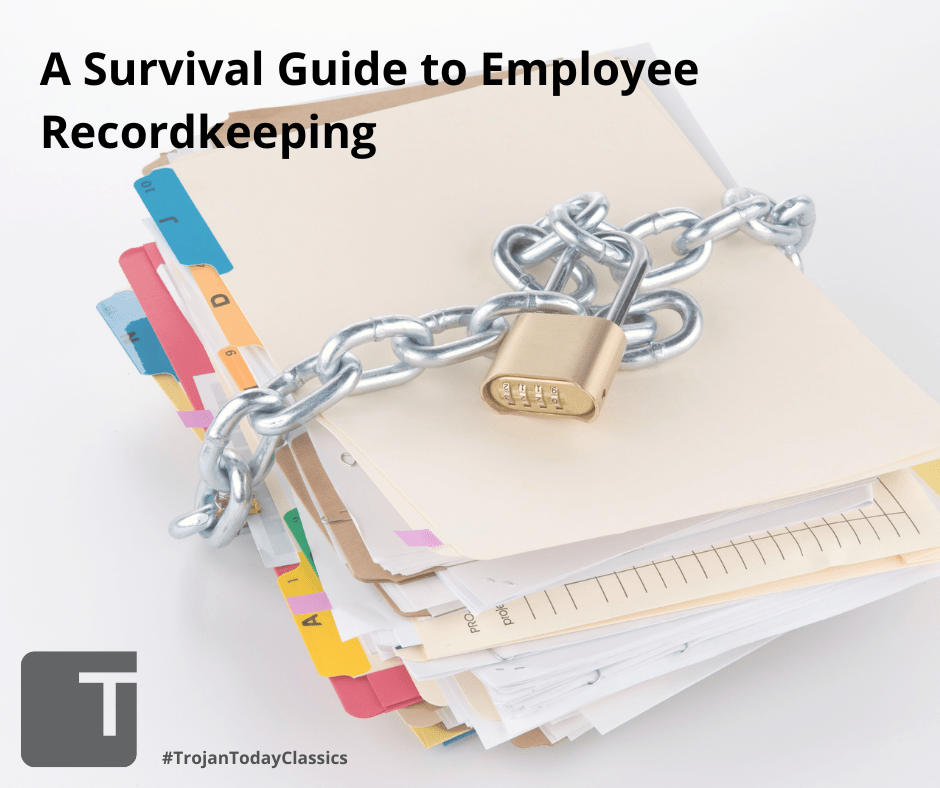Originally published October 2018 in Trojan Today
A dentist’s legal obligation to maintain excellent recordkeeping systems is not limited to his/her patient records. Malpractice lawsuits are not the only liability risk where recordkeeping is concerned; doctors must consider labor board complaints and labor-related lawsuits and the need to protect the practice by ensuring quality recordkeeping standards in the employment arena as well.
Recordkeeping and good documentation are two sides of the same coin. One side is about protection and the other is about compliance.
Federal and state laws mandate recordkeeping requirements for employers. Everything from pre-hire to post-termination has some form of recordkeeping requirement to which employers should adhere. Without the necessary documentation, employers are vulnerable to losing lawsuits or having to pay penalties or fines for lack of compliance.
Employee records related to hiring, promoting, compensating, training, and disciplining employees, etc., which help guide and ensure sound, defensible employment decisions. Proper documentation, retained in employment records, is useful in justifying your decisions and (hopefully) keeps you from making snap judgments. time to sell the practice and invest in updates for the benefit of the next owner.
Types of Records to Keep
There are many different types of personnel records to keep and, depending on the records, different locations to keep them. Personnel records should be divided into three separate files: the Regular File, the Confidential File, and the Form I-9 File.
The Regular File usually contains the following:
- Job application and resumé
- Employment agreement
- Time and pay records
- Attendance and leave records
- Waiver and acknowledgement forms
- Direct deposit authorization
- Employee benefit and enrollment form
- Personnel change forms, such as changes in pay, title, and seniority
- Performance evaluations
- Property held by employee, keys, phones, pagers, other practice property
- Continuing education records
- Disciplinary actions
- Promotion, demotion, transfer, layoff, leave, or termination
The Confidential File typically contains the following:
- Investigative records of grievances or complaints
- Workers’ compensation documents
- Discrimination charges and related documents
- Medical information including the results of physical examinations
- Pre-employment or other drug-test results
- Work restrictions or accommodation requests and results
- Employment reference results, records of references provided to other employers after termination
- Wage garnishment information
- Credit card information
- Domestic violence information
- Documents that identify employees as being in a protected class
- Veterans’ status
Form I-9 File:
We recommend a separate file strictly for I-9 forms. If the U.S. Immigration and Customs Enforcement (ICE) audits you, it is best not to give the ICE representative access to your personnel files. The ability to hand over all I-9 forms in a very organized manner also decreases the amount of time it will take for the audit to be completed.
Record Retention Requirements
Federal and most state compliance regulations impose record retention requirements regarding personnel records. In some cases, state requirements exceed those established by the federal government. When addressing this topic in a particular state, it is advisable to contact the appropriate branch of state government regarding its regulations.
The length of time required for keeping various records on employees varies with the type of information in the files.
The following are general guidelines for some of the most common forms and information:
- Basic information (name, address, date of birth, occupation, rate of pay, SS#, etc.): 3 years from the date of termination.
- I-9 forms: 3 years after the date employment begins or 1 year after the date when employment is terminated, whichever is longer.
- Performance reviews: length of employment plus 3 years.
- Safety records (OSHA Logs, accident reports): 5 years. Hazardous exposure/monitoring reports: 30 years
- (40 years in New York).
- Job orders, job postings and/or advertisements to the public and employees relating to job openings, promotions, training, or overtime opportunities: 1 year from the date the record was made or personnel action was taken, whichever is later.
- Applications and resumés for candidates not hired: 1 year minimum, (2 years in California), recommend 3 years.
- Records relating to hiring (including application and resumés), promotion, demotion, transfer and selection for training, layoff, recall, discharge, or termination: 2 years from the date the record was made or personnel action was taken, whichever is later.
- Information related to leave of absence under Family Medical Leave Act (FMLA) such as medical certification or time off records: at least 3 years.
- Tax information (identification info, remuneration paid, date of payment, FICA and FUTA taxes): 4 years.
- Earnings records: recommend 4 years although payroll records need only be kept 3 years, timecards/sheets 2 years and garnishments/deductions 3 years.
- Retirement and pension records: pension plan documents and service/eligibility records: permanently; pension payments/records: 3 years after death; ERISA plan descriptions/summary annual reports (all records pertinent to covered plans): 6 years.
As a general rule of thumb, keep all documents pertaining to employees throughout the employment relationship plus 4 years from the date of termination. If legal action has been taken or is pending, all relevant records must be retained until final disposition.
Employee Inspection of Records
Most states have enacted laws giving current and past employees the right to inspect certain documents in their personnel records. Even in those states, the right to inspect may be limited. Here are some typical guidelines pertaining to access and inspection of personnel records:
Employee Request To Review Own Personnel Records
Employers can require a written request for each inspection and that an appointment is made for a mutually convenient time when both parties can be present. The employee may request to inspect and/or receive a copy of certain documents in their personnel records based on applicable state laws. The inspection must take place within a “reasonable” time after the request has been made.
Employees must be given sufficient time to read the information and documents may not be altered, added, or removed from the file.
The Type of Records Employees May Review
Employees can read any records that are used or previously have been used to determine “the employee’s qualifications for employment, promotion, compensation, termination, or any disciplinary action.” This includes items such as employment applications, payroll authorization forms, attendance records, layoff notices, performance reviews, discipline records, etc. These documents should be located in the Employee Regular File. Exceptions to the list of records to which employees have access are the documents contained in the Employee Confidential File.
Copying and Note-Taking
Employees can request a copy of their records or take notes based on their inspection, but employees are not allowed to remove or write notes on any document in their file. Be sure that management personnel supervise the review. In most states employers are only required to provide copies of documents that are part of the employee’s regular file.
Safeguarding Records
Whether personnel records are maintained in a file cabinet or in a computer database, the physical safety and privacy of personnel records must be secured at all times. Physical safeguards should include locked files and/or special computer access codes. Entry to the files must be strictly limited on an employer-authorized, need-to-know basis.
Discarding and Destroying Records
As identity theft continues to be more of a problem, employers need to take steps to prevent unauthorized use of, or access to, consumer information through proper disposal techniques. In response to this growing need, The Federal Trade Commission (FTC) has promulgated regulations for the proper destruction of “consumer information.”
Often referred to as the “Disposal Rule,” consumer information includes (a) consumer reports and (b) information derived from consumer reports, provided the information is individually identifiable. When applying this regulation to employers, it is important to recognize “consumer information” also refers to notes or documentation relating to obtained “consumer information” such as a background check. In addition, the “Disposal Rule” encompasses information in both paper and electronic form.
Although employers are required to take “reasonable steps” during the disposal process, the regulations do not outline specific disposal methods that are to be used. We recommend all paper information be shredded or burned, not tossed into a wastebasket. “Reasonable steps” must also be taken to remove data or consumer information from all electronic media.
In Summary
Good recordkeeping is obviously important and highly regulated and, therefore, provides significant exposure to potential liability. Additionally, the quality and comprehensiveness of your records is essential in defending yourself against a personnel-related complaint or lawsuit. A conscientious and compliance-based approach to recordkeeping both prevents problems and becomes your first line of a strong defense.
Tim Twigg is the president of Bent Ericksen & Associates and Rebecca Crane is a Human Resources Compliance Consultant for Bent Ericksen & Associates. FMI: 800.679.2760 www.bentericksen.com.

